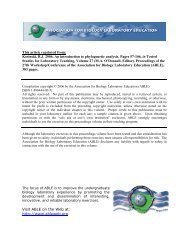A Study of Gene Linkage and Mapping Using - Association for ...
A Study of Gene Linkage and Mapping Using - Association for ...
A Study of Gene Linkage and Mapping Using - Association for ...
Create successful ePaper yourself
Turn your PDF publications into a flip-book with our unique Google optimized e-Paper software.
8 Tetrad Analysis<br />
Figure 1.3. The independent arrangement <strong>of</strong> two pairs <strong>of</strong> homologous chromosomes (Pair 1 <strong>and</strong> 2)<br />
on the spindle’s equator at metaphase I <strong>of</strong> meiosis. Black <strong>and</strong> stipple show parental origin <strong>of</strong><br />
chromosomes.<br />
In Figure 1.4, the upper homologous pair bears the alleles <strong>for</strong> the tan spore gene <strong>and</strong> the lower<br />
pair bears the alleles <strong>for</strong> the gray spore gene. If we assume that the stipple chromosomes <strong>for</strong> both<br />
pairs came from the tan spore parent (g + t) then the alleles present on the stipple chromosomes<br />
would be g + <strong>and</strong> t. If the black chromosomes come from the gray spore parent (g t + ), then the<br />
alleles present should be g <strong>and</strong> t + . Figure 1.4A <strong>and</strong> B show the two possible arrangements <strong>of</strong> these<br />
chromosomes, due to independent assortment, <strong>and</strong> the resulting ascus types. Both kinds <strong>of</strong> asci<br />
shown in Figure 1.4 are the type produced by a meiotic division in which no crossing-over<br />
occurred; only two genotypes <strong>of</strong> spores are present in each ascus <strong>and</strong> they are arranged in a 4:4<br />
pattern. In Figure 1.4A, one-half <strong>of</strong> the spores have a g + t genotype like the tan parent; the other half<br />
have a g t + genotype like the gray parent. This ascus arrangement is called a Parental Ditype (PD)<br />
ascus: ditype because only two genotypes are represented in the ascus <strong>and</strong> parental because both<br />
genotypes are like those <strong>of</strong> the parents. In Figure 1.4B there are also only two genotypes present<br />
(g + t + <strong>and</strong> g t) but neither is like the parents’ genotypes. This ascus arrangement is called a Non-<br />
Parental Ditype (NPD) ascus: ditype, again, because only two genotypes are represented <strong>and</strong> nonparental<br />
because both genotypes differ from the parents.<br />
Situations C <strong>and</strong> D <strong>of</strong> Figure 1.4 show two examples <strong>of</strong> single crossovers occurring between the<br />
centromere <strong>and</strong> the tan locus (C), <strong>and</strong> the centromere <strong>and</strong> the gray locus (D). Recall that there are<br />
four different ways a crossover can occur between the non-sister chromatids <strong>for</strong> each pair <strong>of</strong><br />
homologous chromosomes. In all such cases, an ascus results which contains spores <strong>of</strong> all four<br />
genotypes, arranged in a 2:2:2:2 sequence. It is also possible <strong>for</strong> both chromosomes to be involved<br />
in single crossovers. Some <strong>of</strong> these will produce asci with four spore genotypes in a 2:2:2:2<br />
arrangement (Figure 1.4E); others (Figure 1.4F) will yield asci with only two spore genotypes, but<br />
arranged in a 2:4:2 pattern. All <strong>of</strong> these non-4:4 asci are called Tetratype (T) asci.<br />
Situation G <strong>and</strong> H in Figure 1.4 show how some multiple crossovers involving the chromatids<br />
<strong>of</strong> a single chromosome type can lead to asci that are PD or NPD even though crossover did occur.<br />
We shall later discuss how the occurrence <strong>of</strong> these additional, crossover-produced PD <strong>and</strong> NPD asci<br />
will be a source <strong>of</strong> error in attempts to map the locations <strong>of</strong> these genes. However, since these types<br />
<strong>of</strong> crossovers produce equal numbers <strong>of</strong> PD <strong>and</strong> NPD asci, their existence does not change our<br />
expectations <strong>for</strong> the tan spore × gray spore cross. In summary, we can state the prediction <strong>of</strong> the<br />
unlinked gene hypothesis in the following deductive logic <strong>for</strong>mat:<br />
If the gray spore <strong>and</strong> tan spore genes are unlinked, then the two genes should assort<br />
independently <strong>and</strong> the frequency <strong>of</strong> PD <strong>and</strong> NPD asci should be equal.<br />
� In the space provided below each ascus, fill in the genotypes <strong>for</strong> the four pairs <strong>of</strong> spores <strong>for</strong> each<br />
ascus shown in Figure 1.4. Several have been done <strong>for</strong> you.
















